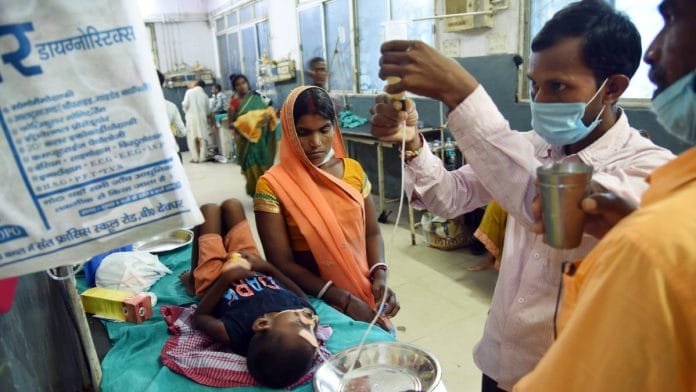New Delhi: In early June this year, an outbreak of acute encephalitis syndrome (AES) began in Gujarat, and since then, 24 districts of a total of 33 in the state have reported cases of the life-threatening condition. Gujarat has reported 137 suspected cases of AES to date, while also recording the deaths of 56 kids, most under the age of 15, due to it.
AES is a group of clinically similar neurologic manifestations, mainly brain inflammation and swelling, that can be caused by several pathogens and toxins.
Similar AES cases from districts in Rajasthan, Madhya Pradesh, and Maharashtra have also been reported. Lab tests were conducted at the Indian Council of Medical Research-National Institute of Virology (ICMR-NIV) and regional labs to detect the pathogen responsible for these cases. These tests confirmed the presence of Chandipura vesiculovirus (CHPV) or Chandipura virus in a large number of cases, not all.
Despite the outbreak not being entirely triggered by CHPV, it has been termed the CHPV outbreak. This is the largest CHPV outbreak recorded in over two decades in the country.
The NIV Tuesday confirmed the presence of CHPV, a virus associated with 55-85 percent fatality, from samples collected from a child suffering from AES in Dungarpur, Rajasthan.
Also read: Hand transplantation surgeries to now be regulated centrally through a nationwide database
Past CHPV outbreaks
CHPV is a member of Rhabdoviridae, a family of bullet-shaped, negative-stranded RNA viruses which include the rabies virus.
Rhabdoviridae is known to cause sporadic cases and outbreaks in western, central, and southern parts of the country, especially during the monsoon season, a scientist associated with the ICMR-National Institute of Epidemiology (ICMR-NIE) explained to ThePrint.
It is transmitted by vectors such as sand flies and ticks.
The virus was named after the site of its first isolation from Chandipura region of Maharashtra in 1965.
So far, CHPV outbreaks have been recorded in five states in the country: Gujarat, Rajasthan, Maharashtra, Madhya Pradesh, and Andhra Pradesh.
But, research has shown that the pathogen remained largely neglected until 2003, when it hit the headlines after being associated with a massive AES outbreak in young children in Andhra Pradesh. That year, there were 329 CHPV cases with 183 fatalities.
Subsequently, another outbreak of AES was reported in Gujarat in 2004, with an alarming case fatality rate of around 78 percent. Another outbreak was reported in Nagpur in 2007, with a high case fatality rate of more than 40 percent. That was when CHPV established itself as a significant emerging deadly human pathogen in India.
Gujarat, Maharashtra and Andhra Pradesh also saw sporadic CHPV outbreaks in 2010 and 2011.
The presence of this virus has been reported in sand flies from Sri Lanka and African countries including Nigeria and Senegal. However, no cases of humans being infected by the pathogen have been recorded in any country other than India.
Quick death caused by CHPV ‘a major concern’
The ICMR-NIE scientist quoted above said that encephalitis cases caused by CHPV occur largely in children, and the condition is characterised by acute onset of fever, altered sensorium, coma or seizures, among others
“Death usually ensues within a few to 48 hours of hospitalisation,” he added.
Dr Jay Shah, consultant paediatric intensivist with Apollo Hospitals, Ahmedabad, told ThePrint that there is no particular antidote or antiviral therapy available against this virus.
“The patients are given supportive symptomatic treatment. Maintaining hemodynamics (how blood flows through the vessel) and providing supportive symptomatic treatment is crucial when the body is responding to the virus,” he said.
However, in those who survive, there is no sequela (aftereffect of a disease, condition or injury) seen due to the vector-borne viral illness.
“Another curious thing about the illness is that the kids who beat the virus quickly recover, within two, three days, despite having suffered a major neurological condition involving the brain,” the ICMR scientist said.
Experts say that prevention is the best method to suppress CHPV infection and contain disease-transmitting vectors. Maintaining good nutrition, health, hygiene and awareness in rural areas are crucial tools to curb the outbreak.
Officials in the Union Ministry of Health and Family Welfare, meanwhile, maintained that experts from the National Centre for Disease Control (NCDC) and ICMR are in Gujarat to help the state manage the outbreak.
(Edited by Radifah Kabir)
Also read: With AIIMS Delhi set to train surgeons in face transplant, a look at the procedure & risks involved






